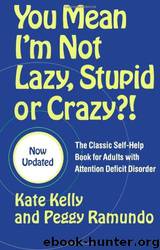You Mean I'm Not Lazy, Stupid or Crazy?!: The Classic Self-Help Book for Adults With Attention Deficit Disorder by Kate Kelly & Peggy Ramundo

Author:Kate Kelly & Peggy Ramundo [Kelly, Kate & Ramundo, Peggy]
Language: eng
Format: epub
Tags: Health & Fitness, Diseases, Nervous System (Incl. Brain), Self-Help, Personal Growth, General, Psychology, Mental Health
ISBN: 9780743264488
Google: 6xK2LraHha8C
Amazon: 0743264487
Publisher: Scribner
Published: 2006-04-24T16:00:00+00:00
In the next chapter, we will go deeper into the realm of relating with a discussion of sexuality, the most intimate kind of relating. In addition, we will explore the topic of ADD and gender issues, including the impact of hormones on ADD symptoms.
Chapter 10
Gender Issues and Sexuality
ADD comes in a rainbow assortment of flavors. We have the “bouncing off the wall” hyperactive types, the “never seem to wake up and get activated” folks and many varieties of activity level in between. Some of us, using almost superhuman effort, keep our noses bolted to the grindstone most of the time. Others are distractible butterflies who can’t stay with a single focus to save their lives. When you add in different learning styles, personality factors and other human differences, the variety is infinite.
One of the most striking differences in how ADD presents itself has to do with gender. In the history of ADD awareness, the focus has been almost exclusively on males. That was because women and girls tend to have a more hidden, subtler form of the disorder. Only recently have researchers begun looking at how ADD manifests in girls and women. It used to be thought that there were as many as nine times more males than females with ADD. We now have research indicating that the ratio may be closer to two to one. There is not enough space in this book to go into great depth on the subject of gender and ADD, so we refer you to the excellent books by Sari Solden and by Patricia O. Quinn and Kathleen G. Nadeau (see Suggested Reading) for more details on this topic. Here are some of the highlights.
Sexy Brains and Hormones
Got your attention? Actually, this is not about the brain and sexual activity, but the fact that male and female brains are different. Of course, you knew that. No doubt you have read or listened to news stories on the latest brain research. We now know that even sexual preference can be linked to variation in size of parts of the brain. We know that there are brain-based differences in ADD. In 1990, Alan Zametkin demonstrated that ADD brains functioned differently from the brains of people without ADD. The frontal lobes are not as active (measured by glucose metabolism on a PET scan) when a person with ADD does a task that requires concentration. Since then, a number of studies have been done that examine various parts of the ADD brain. Two other examples of brain differences in individuals with ADD are (1) the relative size of brain hemispheres (are the right and left hemispheres the same size or different?) and (2) the size of the basal ganglia.
Both of these brain features are also different in males and females. Although the research on gender issues and ADD has barely begun, it is clear that there are biological factors that contribute to the ways ADD shows up differently in men and women.
Hormones: Okay, first we had the anatomy lesson, now it’s time for a minilecture on physiology.
Download
This site does not store any files on its server. We only index and link to content provided by other sites. Please contact the content providers to delete copyright contents if any and email us, we'll remove relevant links or contents immediately.
Should I Stay or Should I Go? by Ramani Durvasula(6784)
Why We Sleep: Unlocking the Power of Sleep and Dreams by Matthew Walker(5641)
Fear by Osho(4085)
Flow by Mihaly Csikszentmihalyi(4052)
Rising Strong by Brene Brown(3780)
Why We Sleep by Matthew Walker(3771)
Too Much and Not the Mood by Durga Chew-Bose(3693)
How to Change Your Mind by Michael Pollan(3676)
The Hacking of the American Mind by Robert H. Lustig(3579)
Lost Connections by Johann Hari(3455)
He's Just Not That Into You by Greg Behrendt & Liz Tuccillo(3300)
Evolve Your Brain by Joe Dispenza(3050)
What If This Were Enough? by Heather Havrilesky(2945)
Resisting Happiness by Matthew Kelly(2886)
Crazy Is My Superpower by A.J. Mendez Brooks(2860)
The Courage to Be Disliked by Ichiro Kishimi & Fumitake Koga(2795)
The Book of Human Emotions by Tiffany Watt Smith(2770)
Descartes' Error by Antonio Damasio(2731)
In Cold Blood by Truman Capote(2684)
